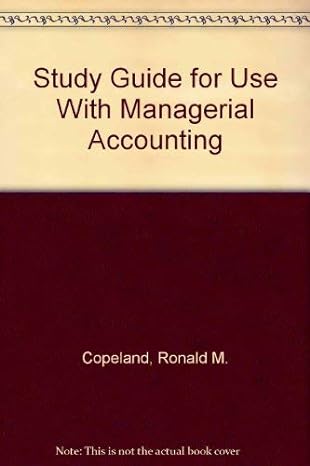Question
Which annual performance evaluation tool, ROI or residual income, might cause a division manager to reject an investment opportunity that would otherwise benefit the company
Which annual performance evaluation tool, ROI or residual income, might cause a division manager to reject an investment opportunity that would otherwise benefit the company as a whole?
A. Residual Income
B. ROI
If the residual income is calculated for a division, and the result is zero, then which of the following must be true?
| a. the division's ROI exactly equals its minimum required rate of return. | ||
| b. the division's ROI is less than its minimum required rate of return. | ||
| c. the division's ROI exceeds its minimum required rate of return. |
Johnson Co. is considering the sale of some obsolete inventory. The inventory cost $8,500 to produce, and can be sold 'as is' for $6,000. Alternatively, Johnson can rework the inventory at a cost of $2,500 and sell the reworked product for $10,000. The financial advantage or disadvantage of a decision to rework the inventory rather than selling it 'as is' would be:
| a. advantage of $1,500 | ||
| b. disadvantage of $1,000 | ||
| c. advantage of $4,000 | ||
| d. disadvantage of $4,500 |
Cash that must be invested in working capital assets over the life of a project will be considered an outflow at the beginning of the project and as an inflow at the end of the project.
| a. True | ||
| b. False |
Which of the following would be an example of a cash inflow for a proposed machine purchase?
| a. The cost to purchase the machine | ||
| b. Salvage value of the machine at the end of its useful life | ||
| c. Repairs and maintenance to be made on the machine during its life | ||
| d. Costs to operate the machine during its life |
Nolan Weller is considering investing $70,000 to start a bookstore. Nolan expects to receive cash inflows from the bookstore of $15,000 at the end of each year for the next six years. At the end of the sixth year, Nolan believes he can sell the business for $85,000 cash. Using a 15% minimum required rate of return, what is the net present value of the bookstore investment? (ignore taxes)
| a. $56,700 | ||
| b. $36,050 | ||
| c. $70,000 | ||
| d. $23,480 |
Anthony operates a part-time auto repair service. He estimates that a new diagnostic computer system will result in increased cash inflows of $18,000 in year 1, $24,000 in year 2, and $30,000 in year 3. If Anthony requires a return of 14% on all investment projects, then the most he would be willing to pay for the new computer system would be: (ignore taxes)
| a. $57,294 | ||
| b. $56,141 | ||
| c. $54,492 | ||
| d. $52,916 |
If the minimum required rate used to compute the net present value of an investment is the same as the investment's internal rate of return, then the net present value of the investment must be:
| a. Unknown | ||
| b. Negative | ||
| c. Positive | ||
| d. Zero |
The Laws company has decided to buy a machine costing $200,000. Estimated cash savings from using the new machine amount to $41,675 per year. The machine will have no salvage value at the end of its useful life of eight years. The machine's internal rate of return is closest to:
| a. 15% | ||
| b. 13% | ||
| c. 14% | ||
| d. 16% |
The payback period of an investment is a good alternative to the use of net present value analysis to determine whether a potential investment will earn more than the company's minimum required rate of return.
| a. True | ||
| b. False |
A new machine costing $832,000 will yield cash savings of $155,000 each year for seven years. In addition, it is anticipated that the new machine will increase productivity and that the company will experience an increase in contribution margin as a result. What annual dollar inflow from increased contribution margin would the company have to experience to make the machine an acceptable investment if the minimum desired rate of return is 15%?
| a. $64,000 | ||
| b. $86,000 | ||
| c. $45,000 | ||
| d. $35,000 |
Jacobs Co. is considering buying several small tools at a cost of $15,000. The new tools will save the company $5,500 in manufacturing costs each year and are expected to last 4 years. Assume salvage is $3,000 and the tax rate is 34%. Jacobs uses the MACRS method to compute depreciation for tax purposes. The MACRS depreciation rates are: 33.3% in year 1, 44.5% in year 2, 14.8% in year 3, and 7.4% in year 4. Using a minimum desired after-tax rate of return of 12%, the net present value of this investment is: (include the effect of taxes and round present values to the nearest cent)
| a. ($1,064.78) | ||
| b. $1,533.42 | ||
| c. ($1,107.47) | ||
| d. $1,386.41 |
Step by Step Solution
There are 3 Steps involved in it
Step: 1

Get Instant Access to Expert-Tailored Solutions
See step-by-step solutions with expert insights and AI powered tools for academic success
Step: 2

Step: 3

Ace Your Homework with AI
Get the answers you need in no time with our AI-driven, step-by-step assistance
Get Started


